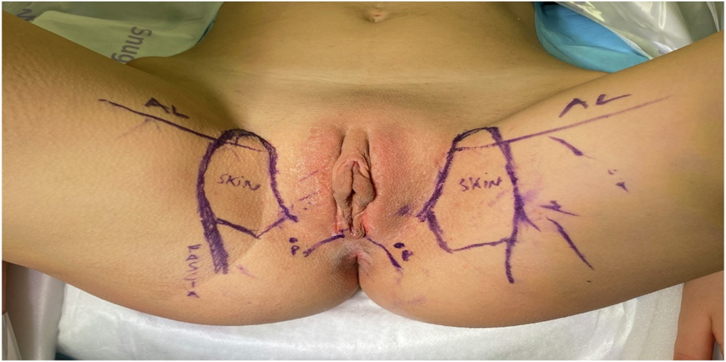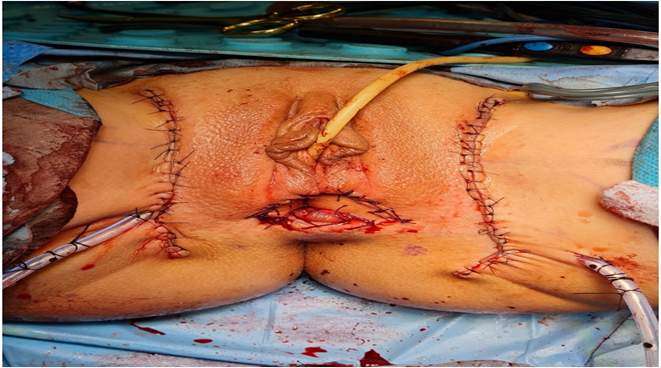Short Communication
Possibility of Generation of An Efficacious Neovagina in Cases of Mayer Rokitansky–Kuster–Hauser syndrome with Satisfactory Vaginal Length, and Sexual Working of the Neovagina with an Innovative Technique-A Short Communication
1Scientific Director, Human Reproduction Scientific Director cum Owner 721, G.T.B. Nagar, Jalandhar-144001 Punjab, India.
2Scientific DirectorEx-Rotunda-A Centre for Human Reproduction 672, Kalpak Garden, Perry Cross Road, Near Otter’s Club, Bandra(W)-400040 Mumbai, India. 3Consultant Neurologist, Swami Satyanand Hospital Near Nawi Kachehri, Baradri, Ladowali road, Jalandhar Punjab, India.
*Corresponding Author: Kulvinder Kochar Kaur, Scientific Director, Human Reproduction Scientific Director cum Owner 721, G.T.B. Nagar, Jalandhar-144001 Punjab, India.
Citation: Kulvinder K. Kaur, Gautam N. Allahbadia, Singh M. (2024). Possibility of Generation of An Efficacious Neovagina in Cases of Mayer Rokitansky–Kuster–Hauser syndrome with Satisfactory Vaginal Length, and Sexual Working of the Neovagina with an Innovative Technique-- A Short Communication’. Journal of Women Health Care and Gynecology, BioRes Scientia Publishers. 4(2):1-4. DOI: 10.59657/2993-0871.brs.24.064
Copyright: © 2024 Kulvinder Kochar Kaur, this is an open-access article distributed under the terms of the Creative Commons Attribution License, which permits unrestricted use, distribution, and reproduction in any medium, provided the original author and source are credited.
Received: September 19, 2024 | Accepted: October 09, 2024 | Published: October 16, 2024
Abstract
Earlier we have extensively detailed Mayer Rokitansky–Kuster–Hauser Syndrome as well as procedures meant for generation of neovagina inclusive of utilization of graduated dilators of the non-surgical methodologies in the generation of neovagina dilators. Here our presentation is the manipulation of other surgical methodologiesdetailed is the innovative dissection of the neovagina utilizing bilateral 12 x5 cm fasciocutaneous skin flaps from the labiocrural folds implicating substantially greater dissection in contrast to other tissue grafts as well as there was prolongation of surgical time period in addition to stay in the postoperative period. Nevertheless, the plausible benefits of such tissue graft regions (for instance sufficient vaginal length, width leading to sexual working of the neovagina) might finally provide greater working postoperative results in contrast to other tissue grafts utilized with greater frequency. Need for the objective determination of nerves as well as sexual working is there in reference to theoretical estimation of such surgical methodology leads to greater advantages prior to the broader utilization of the tissue grafts by multidisciplinary teams gets put in to action.
Keywords: neovagina generation; innovative surgical approach; fasciocutaneous skin flaps labiocrural folds; sufficient vaginal length; width
Introduction
Earlier we have extensively detailed Mayer Rokitansky–Kuster–Hauser Syndrome as well as procedures meant for generation of neovagina so much so that we had been using amnion grafts inserted in the vagina created wrapped over a mould created from the dental department[1-3].Further we had reported the 40th case in world literature who presented as hydrometrocolpos born in my duty in Saudi Arabia which after diagnosing operated with the paediaric surgeon to create a neovagina initially using a paediatric foley catheter and drainage of the haematometra where initial despite lot of diagnostic hurdles with emphasis by paediatricians on teratoma somehow reaffirmed the diagnosis &operated [4]. Further this arena had been on standstill till the recent innovation.
Existence of occasional gynaecological surgeries are there which possess plethora of efficacious strategies akin to vaginoplasty. The basic expositions for the same is that every kind of particular procedure possesses its own benefits as well as disadvantages. Categorization of such procedures might be performed is made into i) surgical in addition to ii) non-surgical methodologiesof the generation of neovagina [5]. Non-surgical management basically implicate vaginal dilation with the utilization of graduated dilators meant for fashioning a working vagina (detailed by us in ref 1). This generally constitutes the first line of management in view of it being substantially successful in case of subjects who comply to the instructions, with the utilization of regional vaginal tissue along with leads to avoidance of the risks implicated in surgery [6]. For the cases where surgery is the requirement, surgeons might advocate variety of procedures along with vaginal surgery, might or might not need abdominal surgery (Vecchieti or Davydov operation) as well as might or might not need autologous or allogenic tissue grafts (McIndoe/ intestinal vaginoplasty/ Williams vaginoplasty). Subsequent to exhaustive counselling, subjects’ predilection along withsurgeon experienced in procedure or not would ultimately aid in decision making of advocated strategy.
The acknowledgement that even currently a plethora of surgical strategies get frequently utilized along with possess acceptability implies existence of no benefits of any single strategy in contrast to others. Furthermore, its implications are existence of further getting innovative in generating a strategy in reference to maximization of the outcomes obtained regarding achieving a successful procedure in addition to minimization of the risks correlated with surgery as well as at the time of recovery. At the time of vaginoplasty operation, maximal significant result needing idealization of the methodology inclusive of anticipated vaginal length, width as well as sexual working of the neovagina. The risks of surgery to be taken into account are inclusive of damage, fistula generation with the urinary bladder or bowel, vaginal stenosis, vaginal prolapse in addition to wound repair from the autologous tissue graft regions. Such risks, in part get correlated with duration of the surgery, magnitude of the requirement ofdissection, along with time taken for the recovery.
Akin innovative strategy got recently illustrated by Uccella et al. [7], who detailed an innovative surgical format implicating bilateral labiocrural fasciocutaneous flaps in the form of autologous tissue grafts. They illustrated how they had generated innovative technique which implicated use of interdisciplinary team of gynaecologists as well as plastic surgeons. They detailed dissection of the neovagina utilizing bilateral 12 x5 cm fasciocutaneous skin flaps from the labiocrural folds. This surgery attained success in the sense that adequate vaginal length, as well as width 2 yrs subsequent got observed which aided in coitus (see Figure1 & Figure2). Additionally, this subject underwent a smooth post-surgical time period without generation of complications.
Figure 1: outlined fasciocutaneous flaps for dissection
Figure 2: Completed Procedure
Subsequent step is theassessment of manner working of the such graft region in contrast to other presently utilized grafts. Definitely, the degree of requirement of dissection is substantially greater in contrast to other graft procedures. Thereby, such surgery might possess plethora of complications in addition to correlated morbidity which needs cautious assessment in a larger cohort study. Additionally, in view of substantially long dissection with documented operation time period of 6hrs, a definite clearcut benefits of such strategy to be isolated prior to it being advocated in the form of a routine procedure.
Of one of the benefits such tissue graft is the conservation of the blood supply (originating from the labial artery) subcutaneous fat as well as innervation. Uccella etal. [7], documented that patient had sustenance of the neovaginal sensations at the time of 2 yrs follow up. Once such blood along with nerve supplies leading to lesser risk of failure of grafts in addition to scores of the sexual working in contrast to other methodologies, this might work in the form of greater advantageous in contrast to other procedures, further yielding the magnitude of the surgery need along with foraging such tissue. For gaining greater insight requirement of surgeons is of doing nerve conduction studies by gaining greater insight in reference to objective asssessment of working of nerves of such tissue in the post operation time period. Further than this such patients have requirement of asssessment of objective estimator of the sexual working for instance Female sexual function score. Such scores apart from utillity in illustrating that such procedure is efficacious in the generation of a working neovagina, might further aid for the contrasting of thesexual working amongst this as well as other frequently utilized surgical strategies [8].
A significant factor that was emphasized by Uccella etal.[7], was at the time of utilizing labiocrural tissue needs to be taken into account, not observed while utilizing other tissue grafts at the time of vaginoplasty is the existence of terminal hair growth. The elimination of hairs that are believed tobe unwanted subsequent to a tissue graft has been detailed with greater frequency subsequent to placing a tissue graft in the oral cavity with utility of plethora of protocols which have been assessed at the time of preoperative utility [9]. Guaranteeing epilation, in the detailing by Uccella etal. [7], continues to be a significant step at the time of preparing for the utility of such tissue.
Conclusions
Thereby, Uccella et al. [7], presentation of the procedure in a video format detailed an innovative surgical technique for the generation of a working neovagina utilizing autologous fasciocutaneous labioscrotal graft which spares blood supply as well as nerves in their patient presented led to a sufficient vaginal length, width leading tosexual working of the neovagina. Furthermore, greater dissection was the need forthe procurement of the fasciocutaneous skin flaps from the labiocrural folds, that was substantially greater in contrast to other tissue grafts as well as there was prolongation of surgical time period in addition to stay in the postoperative period. Nevertheless, the plausible benefits of such tissue graft regions might finally provide greater working postoperative results in contrast to other tissue grafts utilized with greater frequency. Need for the objective determination of nerves as well as sexual working is there in reference to theoretical estimation of such surgical methodology leads to greater advantages prior to the broader utilization of the tissue grafts by multidisciplinary teams gets put in to action [10].
References
- Kulvinder Kochar Kaur, Allahbadia GN, Singh M. (2016). An Update on the Causes of Primaryand Secondary Amenorrhea alongwith Aetiopathogenesis and Therapeutic Management. Avid Science Monograph Series, 1-87.
Publisher | Google Scholor - Kulvinder Kochar Kaur, Allahbadia GN, Singh M. (2020). An Update on the Advances in Classification as well as Reproductive Surgeries in Mullerian Anomalies - A Systematic Review. Am J Surg Tech Case Rep, 1(1):1002.
Publisher | Google Scholor - Kulvinder Kochar Kaur, Allahbadia GN, Singh M. (2023). The Role of Reproductive Surgeons/Surgery has Got Rekindled with Plateauing of IVF Results and Advances in Technology: A Comprehensive Narrative Review. J Obst Gynecol Surg, 4(2):25-36.
Publisher | Google Scholor - Kulvinder Kochar Kaur. (1993). Hydrometrocolpos -A Case report – Poster presentationhed at the SIRCOG, Hong Kongin.
Publisher | Google Scholor - Pfeiffer SM, Attaran M, Goldstein I, Lindheim SR, Petrozza JC, Rackow BW, etal. (2021). ASRM Mullerian anomalies classification in 2021. Fertil Steril, 116:1238-1252.
Publisher | Google Scholor - Edmonds DK, Rose GL, Lipton MG, Quek J. (2012). Mayer Rokitansky–Kuster–Hauser Syndrome: A review of 245 cases managed by multidisciplinary approach with vaginal dilators. Fertil Steril, 97:686-690.
Publisher | Google Scholor - Uccella S, Galli L, Vigato E, D’Alessisio P, dePaola M, Garzon S, etal. (2024). New vagina creating on the basis of fasciocutaneous flaps for Mullerian Agenesis. Fertil Steril, 122:382-384.
Publisher | Google Scholor - Martens L Tannenbaum L, vanKuijk SMJ, Notten KJB, Kluvers KB. (2024). Laparoscopic Davydov vs Laparoscopic Vecchieti neovaginoplasty in women with Mayer Rokitansky–Kuster–Hauser Syndrome: systematic review and meta-analysis. Fertil Steril, 121:679-692.
Publisher | Google Scholor - Rahpeyma A, Khajehahmadi S. (2017). A protocol for management of the hair problems in oral cavity reconstruction by submental flap. J Maxillofac Oral Surg, 16:108-112.
Publisher | Google Scholor - Romanski PA, Bortoletto P, Pfeiffer SM. (2024). bilateral labiocrural fasciocutaneous flaps for vaginoplasty: when two become one. Fertil Steril,122:276-277.
Publisher | Google Scholor













